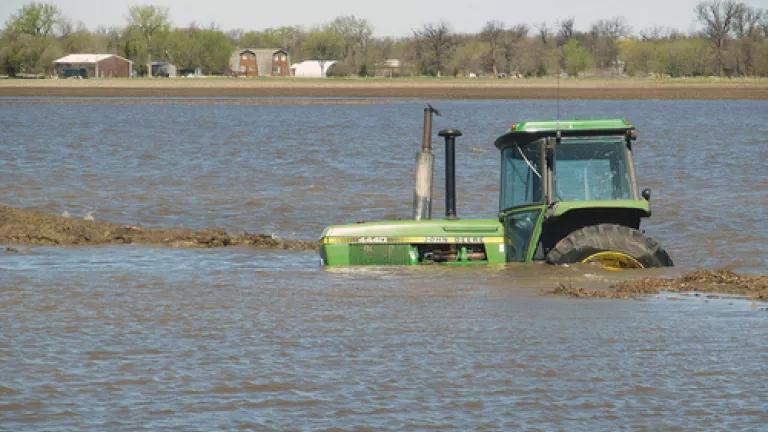
In recent years, the impacts of extreme weather and climate change have been felt in communities across the U.S. In 2012, eleven different extreme weather events, from severe storms and flooding to extreme heat and drought caused over $1 billion in damages each. In what was the hottest year on record in the U.S., scorching heat brought drought conditions to more than 65 percent of the country and helped to fuel wildfires in the West that burned more than 9.2 million acres. These record-breaking drought conditions devastated agricultural crops and livestock, led to water restrictions in afflicted communities, and halted commerce on the Mississippi River. On some farms, wells even ran dry, leaving crops to bake in the heat. And as prices for critical field crops like corn and soybeans rose and pastures dried up, many ranchers were forced to sell off their livestock. As a result, higher food prices rippled across the country, hitting families in their pocketbooks.
- May 2013 flooding in North Dakota (photo credit: Keith Weston/USDA)
A similar story of extreme weather unfolded this year with severe storms, flooding, record-breaking heat, wildfires, and drought affecting communities throughout the nation. In contrast to extreme drought conditions last year, drenching rains and heavy flooding in the Midwest this year delayed or prevented farmers from planting crops in many areas, and even drowned newly planted seeds in others. And while this excessive flooding helped to temporarily ease drought in some places, other areas yet again are experiencing alarming drought, with nearly 80 percent of the West and over 60 percent of the High Plains currently plagued by drought conditions.
As carbon pollution continues to fuel climate change and extreme weather, droughts and floods, wildfires and torrential rains, too much water and not nearly enough will continue to devastate communities year after year. These are the warning signs of a changing climate. As we’ve seen far too often, drought conditions and hotter temperatures threaten critical water supplies for farmers, municipalities, and industries while, at the same time, increasing water demand for irrigation and power production. Heavier rainfall events increase flooding risks for agricultural areas and communities, threatening public health and safety as pollutants like fertilizers and untreated sewage flow into our streams and rivers.
Many of the states that have suffered unrelenting drought and crop losses in recent years are the same states that are the least prepared for the impacts of climate change. These states are doing little to nothing to help prepare for these challenges, making it even more important that farmers have the best resources available to protect their crops and the nation’s food supply.
As detailed in our newest report, Soil Matters, methods to build soil health and improve water management help to limit crop losses in the face of extreme weather and climate change. Best management practices like cover cropping, no-till farming, and improved irrigation handling improve soil health and allow soil to absorb and store water, whenever it falls, making it available for crops when needed.
The Federal Crop Insurance Program can and should encourage these water-saving management practices to help farmers climate-proof their fields.
